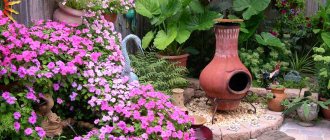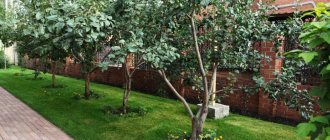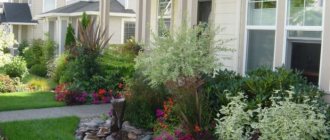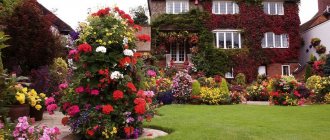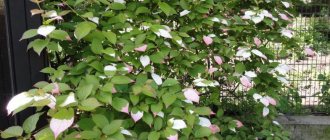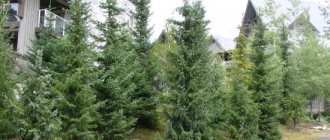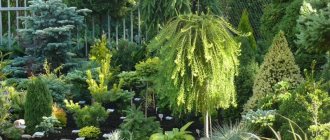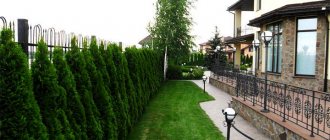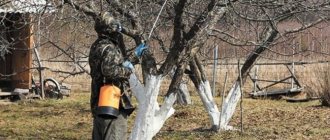Every owner of a country property dreams of decorating their property with an emerald lawn. However, lawn care is often a very thankless task. The grown grass does not look at all as picturesque as on the package with seeds; in winter it freezes, forming bald spots. Moreover, it becomes overgrown with weeds and turns yellow.
Photo: https://uclachoralmusic.com/wp-content/uploads/2019/03/don-t-bother-fertilizing-your-lawn-twice-a-year-consumer-reports-vs.jpg
Main characteristics
In landscape design, there is a special class of herbs that either do not bloom at all or bloom unnoticed. These are ornamental herbaceous plants. Some look so impressive that it is no longer possible to imagine a modern flowerbed or front garden without them. There are a great many herbaceous plants in nature. There are about 18,000 of them in Russia alone. But of course, not all herbs can be classified as ornamental.
Herbaceous plants are plants that do not have perennial above-ground characteristics, they do not have woodiness of the stem, and at the end of the growing season they die off. Herbs form a root system and shoots: leaves, stem and flower part, if any.
Classification of herbaceous plants
Herbaceous plants are classified according to various criteria. But grouping plants by lifespan is considered the most convenient. Their examples:
- Annuals, after completing the growing season or flowering and fruiting, die off completely, without the possibility of resumption of growth. Such plants reproduce exclusively by seeds.
- Biennials complete their life cycle in two years. During the first season they develop shoots and roots. At the end of the growing season, their stem dies off in the same way as that of annuals, but the underground part survives to produce flowering shoots next year. Complete death occurs at the end of flowering.
- Perennials differ from biennials by the presence of rhizomes, bulbs or tubers, which have a longer renewal period. But their above-ground shoots die off in the same way when the growing season ends. After a year, under the influence of heat, new roots and young shoots sprout from living tissue.
North side of the house
Here you can plant horizontal juniper, thuja, blue spruce, microbiota, virgin grapes, honeysuckle, and astilbe.
Juniper
Horizontal juniper came to us from North America. It grows well on hillsides and sandy shores of ponds. It is a creeping shrub up to a meter high, with unusually curved branches. It is frost-resistant, does not require special care and will give the northern corner of your garden a special decorative effect.
Decoration of the world
Decorative plantings are widely used to improve the landscape: near houses, grasses are displayed in flower beds and front gardens, they decorate squares and park areas in cities. Thematic compositions and modular flower beds, porters and borders are created from annuals, biennials and perennials.
Conventionally, ornamental plants are divided into deciduous and flowering:
- decorative deciduous - mosses, cereals and ferns;
- beautifully flowering - flowering plants and meadow grasses.
Today, the range of herbs is diverse, which makes the choice much more difficult. But the decision should be made based on more than just appearance. It is important to know the growing conditions and other characteristics, which may differ significantly depending on the type of plant.
Decorative deciduous grasses
Plants with decorative foliage delight the eye with splendor and variety from spring until the first frost.
Wormwood is a biennial or perennial herbaceous plant. There are many types of wormwood, and some are even listed in the Red Book of Russia.
Most types of wormwood grow up to 60-70 cm in height, but there are also those whose growth can exceed 1.5 m. The stems of the plant are straight and branched, pubescent. The leaves are elongated and pointed, silvery in color. The flowers are small, collected in inflorescences, usually white or yellow. Wormwood has a pleasant aroma with a slight bitterness.
To grow decorative wormwood, you need well-drained soil and a site located on the sunny side.
Mint is not only a healthy and fragrant herb, it also has decorative properties. Mint is a perennial plant with many species, but the most common are fragrant and peppermint.
The stems of fragrant mint reach a height of up to 40 cm, they are straight and stable. The leaves are green with a light edge, wrinkled, and exude a pleasant aroma.
Peppermint can reach a height of 120 cm. Its stems are straight, tetrahedral, branched, and well-leafed. The leaves are green with a purple edge, elongated-ovate, pointed and jagged.
Mint is an unpretentious plant, but it grows and reproduces better in fertile and well-moistened soil. More illuminated areas are optimal for growing.
Sheep fescue is an ornamental grass. The plant does not form a rhizome and differs from other fescue trees in its softer foliage.
Sheep fescue grows in a dense bush, growing from 20 to 140 cm in height. The leaves are bristly and can be different in shape: from wide to especially narrow. Fescue blooms with oblong panicles of light green spikelets.
Tall and low annuals
Annual flowers are suitable for those who like variety in their flower beds - they can be used to create picturesque compositions. Annuals are often planted in flowerpots and flowerpots. Everyone is well aware of the following names of plants in the yard that are planted every year:
- marigold;
- zinnias;
- asters;
- petunias;
- begonias;
- Snapdragon;
- poppies;
- calendula.
These flowering annuals are unpretentious and do not require much care. They grow quickly and bloom all summer.
Marigolds are one of the plant species most common in the middle zone. There are a large number of different marigolds: terry, smooth, chrysanthemum-shaped. Their color ranges from lemon yellow to dark brown. New varieties of flowers are constantly appearing. Marigolds have medicinal and insecticidal properties. They easily tolerate transplantation in a blooming state, which is why they are used to fill empty spaces in flower beds.
Zinnias are bright large flowers of various colors that look good in flower beds, rockeries and alpine hills. They prefer sunny places. Petunias, beautiful flowering plants of various shapes and colors, are extremely popular among designers. Low-growing varieties are used to decorate flower beds, and cascading varieties are grown in flowerpots.
Asters are also well-known and popular flowers. They bloom in summer and bloom until late autumn. There are many varieties of asters - low-growing and tall, simple and double. Suitable specimens can be selected for any flower garden.
!The world around us, grade 2, part 1, ANSWERS, Pleshakov, Perspective - Grass near our house
Page 16 of 28
GRASS AT OUR HOUSE
1. Cut out the pictures from the Appendix and place each plant in its own window.
2. Color the plants (tansy, burdock, shepherd's purse)
3. Consider the herbaceous plants around your home. Write them down.
- clover, bluegrass, foxtail, yarrow, knotweed (bird buckwheat), plantain, dandelion, mint, burdock.
Draw 2-3 plants. See photo.
Write a story about one of the herbs growing near your house.
There is mint growing near our house. This plant has a very pleasant smell. We often collect mint, dry its green leaves and add it to tea. I like to drink mint tea.
There are several types of mint, including medicinal plants.
Our website has a VKontakte group “GDZ - Ready Homework - Answers Reshebnik”. Join us!
Grass seeds for urban gardening. An ordinary lawn that grows in the city.
“Lawn Yard on Leninsky” offers grass mixtures for landscaping within the city near residential buildings and in parks. Optimally balanced composition, only perennial herbs, quality guarantee. Our telephone numbers in Moscow: +7, +70 [email protected]
City courtyards should look much more impressive and well-groomed than a village courtyard. But it's more complicated than just planting a lawn and mowing it periodically. What grass mixtures are suitable for the city and how to make a house plot “like in the picture”?
When talking about lawns around the house, you need to understand that in the city these are small areas that require regular maintenance and high aesthetic appeal. Gardeners and landscape designers rarely do anything super-complicated or extremely unusual on areas in front of buildings in the city; at most they plant shrubs that can be trimmed or create flower beds. And, of course, at such sites there is always a lawn, proper and of high quality.
Flowering shrubs
Shrubs are traditionally used to decorate the area near the house. They require much less care than flowers. Shrubs can be either flowering or fruiting. The following unpretentious and frost-resistant plants are usually planted in home areas:
- Lilac, whose fragrant clusters bloom in early spring. Caring for it is simple - the bush is occasionally watered, fed and dry branches are cut off.
- Spiraea is a lush flowering shrub with spectacularly colored flowers and leaves. He is unpretentious and hardy. Spiraea is used in various landscaping options. You can choose varieties that bloom in both spring and autumn.
- Budleya is a shrub that blooms with large flowers of different shades of lilac. Flowering continues from July until late autumn. Immediately after its completion, the bush needs pruning.
- Hydrangea delights gardeners all summer with its large, elegant inflorescences. It needs regular feeding and mandatory pruning. The plant tolerates even the most severe frosts well and does not need shelter.
- Weigela blooms twice a year - in spring and late summer. Its flowers come in the form of white, pink, red and cream bells. This heat-loving shrub develops well in a dark place and needs shelter in winter.
- Deutzia is an exotic plant that recently appeared in our gardens. During flowering, it is completely strewn with small white, pink or brown flowers. Deutzia looks great against the backdrop of conifers and forms spectacular compositions in combination with other flowering plants.
- Thorn is a shrub whose fruits can be eaten. Its growth can reach three meters, so the plant must be pruned regularly. Blooming thorns give off a pleasant aroma.
- You can also plant rose hips, viburnum and hawthorn in your yard. These shrubs bloom beautifully in the spring, and bright and elegant fruits ripen on them in the fall. They are unpretentious in care and are highly frost-resistant.
Why is it more difficult to choose lawn grass for sowing in the city?
The problem with local areas in the city is depleted soil and a not very healthy atmosphere. In addition, if the adjacent area is located in front of a multi-story building or you have children and pets, then such a lawn will be trampled much faster and more severely. So, a lawn for sowing in front of a house in urban conditions should be:
- resistant to trampling;
- not demanding on the quality of the atmosphere;
- does not require frequent watering;
At the same time, the grass cover should be dense and bright so that there is no need for constant reseeding of bald spots.
Folk remedies for weeds
How to water the grass to prevent it from growing is decided strictly individually and taking into account your interests. Here you can use specialized science-based approaches or folk remedies. For example, sprinkle salt on a weed plant, but salt can also eat cultivated plants, so you need to carefully treat it with a solution or water the grass so that it does not grow with diesel fuel or alcohol, especially in a cucumber bed.
Traditional methods of weed control Source dhresource.com
When choosing how to remove grass from a plot using folk remedies , people most often pay attention to the following:
- Method 1 is a hoe, hoe, shovel, trimmer, i.e. mechanical, in which weeds are manually removed, and subsequently they do not interfere with the growth of vegetables and berries.
- Method 2 - the same saline solution, but if salt licks or malt predominate in your area, then it’s better not to, there’s no need for extra salt.
- Method 3 is to use an effective means of removing grass from the area, such as ameliorant, i.e. change the acidity of the soil, for example, if biting midge or horsetail grows on the site, this means that the soil is acidic, which means you need to use either semi-rotted horse manure (horse) with neutral acidity, or ameliorants (dolomite flour, lime, marl). If the soil is highly alkaline, use gypsum.
Which grass mixtures are definitely suitable for urban areas?
has been working in the field of landscaping for many years, during which time our specialists have developed many combinations of herbs that perform certain functions and have unique properties. Two of them are ideal for solving the problem:
1) "Urban".
Timothy grass and meadow fescue in this grass mixture are responsible for dense grass cover and rapid growth, and perennial ryegrass for color and decorativeness. Each of these lawn grasses in itself is not too fancy, but in combination they create a very beautiful lawn that is almost impossible to “kill” with bad weather or exposure to it (walks, active animal games). The correct percentage of seed in the grass mixture (30% timothy and ryegrass each and a little more fescue) helps maintain the aesthetics of the lawn in the most difficult conditions - gas pollution, not very frequent watering, infrequent fertilizing.
Briefly about the main thing
There are a wide variety of weed species that need to be controlled correctly and efficiently. To competently destroy unnecessary herbs on your site, you need to know their classification, understand their biology and choose the right method to combat them.
Mechanical and biological methods are good because they are environmentally friendly - poisons are not used here, i.e. your site will be clean and well-groomed, and the vegetables and berries will be healthy. However, a lot of manual labor is required.
Chemical control measures are less labor-intensive, but also not always environmentally safe - they can pollute or over-sterilize the soil, so they should be used in emergency cases.
People's advice shows the greater effectiveness of weeding and the use of saline solutions and ameliorants.
But in any case, there is no universal advice, and what to water the grass to prevent it from growing must be decided on the spot.
Ratings 0
General recommendations for urban lawn care
If you decide to create a lawn in the city, you should understand that, compared to a regular lawn on a garden plot, it will be more difficult and will require more effort at the stage of first sowing the lawn or lawn areas.
1) The soil must be “nourished” before sowing grass mixtures. Urban soil is depleted and spoiled by a poor quality atmosphere, which means it is unlikely to be “favorable” to seeds. Do not use universal fertilizers, find out the type of soil and use special fertilizers that help solve the problems of this particular soil type.
2) It is necessary to remove all roots, stones, glass, and plastic from the soil. Dig up the area and clean it by hand or with a rake, otherwise it will be very difficult for the lawn to grow evenly throughout the entire area.
3) Use only high-quality grass mixtures. Do not sow urban areas with monograsses; this can lead to constant overseeding, simultaneous damage to the grass cover and a greater spread of weeds.
4) Be sure to feed the lawn with nitrogen fertilizers and aerate it at least once every six months. Don't worry about doing this often; the right grass mixture is strong enough to grow nice and dense in urban soil conditions.
5) Try to immediately mark the paths if the area involves walking through it.
Otherwise, your lawn will simply be trampled down in a few weeks.
To purchase grass mixtures “City” and “Universal”, please contact us. Our telephone numbers in Moscow: +7 (495) 294-80-80.0 [email protected] Also, the specialists at Lawn Yard on Leninsky will be happy to help you with the choice of high-quality lawn grass and good fertilizers.
How many discoveries can be made right near your home! Why travel beyond distant forests, beyond high mountains, when uncharted territory begins behind your porch? Armed with a plant identification guide and a camera, the kids and I began hunting for plants. What is still growing under our very noses? Here's what:
1. Smolyovka (lat. Siléne) is a genus of flowering plants of the Carnation family:
There are about 400 genera of Smolevkas. I've also met others like this. As children, we clicked them on each other’s foreheads:
Sweet clover (lat. Melilótus officinális)
3. Shepherd's purse, or Purse (lat. Capsella) is a genus of herbaceous plants from the Brassicaceae (Cruciferous) family.
The Latin scientific name is given by the shape of the fruit: lat. capsella - box, casket.
4. Quinoa (lat. Átriplex) Chenopodiaceae family:
5. Woodlice, or more precisely, Stellaria média (lat. Stellária média) is a species of plant in the Carnation family:
5. Forget-me-not. (Latin Myosótis, from the ancient Greek “mouse ear”) is a genus of plants of the Borage family. I won’t say what type it is.
Possibly field or marsh:
6. Stinging nettle (lat. Urtíca dióica) - where would we be without it:
7. Surepka, or Surepitsa (lat. Barbaréa) is a genus of herbaceous plants of the Brassica family (as Wikipedia says). At school, we studied this family as CRUCIFLOWERS. 4 petals form a cross, hence the name:
8. Burdock (lat. Árctium), completely covered with aphids (at the same time as zoology) is a genus of biennial plants of the Asteraceae, or Compositae family. The plants are well recognized by their inflorescence-baskets, the outer leaves of which are subulate-pointed and hooked at the ends. By the way, do you know that humanity owes the invention of contact tape (Velcro, Velcro) to burdock heads, or rather to its seeds, which cling to clothes?
9. Yarutka. (lat. Thláspi) is a genus of plants in the Brassica family. Yarutka is easy to remember by the interesting shape of the fruit (pod). The fruit valves are scaphoid, almost always winged.
10. Columbine , or Orlik, or Aquilegia from the Ranunculaceae family.
“>
